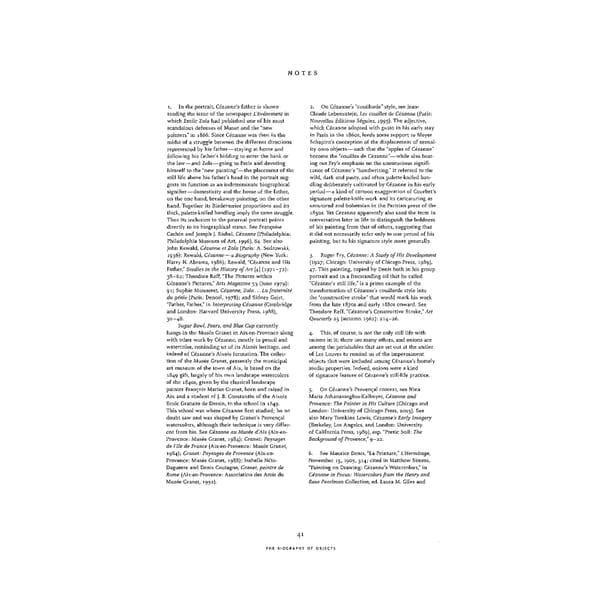NOTES i. In the portrait, Cezanne's father is shown 2. On Cezanne's "couillarde" style, see Jean- reading the issue of the newspaper L'Evenement in Claude Lebensztejn, Les couilles de Cezanne (Paris: which Emile Zola had published one of his most Nouvelles Editions Seguier, 1995). The adjective, scandalous defenses of Manet and the "new which Cezanne adopted with gusto in his early stay painters" in 1866. Since Cezanne was then in the in Paris in the i86os, lends some support to Meyer midst of a struggle between the different directions Schapiro's conception of the displacement of sexual- represented by his father—staying at home and ity onto objects—such that the "apples of Cezanne" following his father's bidding to enter the bank or become the "couilles de Cezanne"—while also bear- the law—and Zola—going to Paris and devoting ing out Fry's emphasis on the unconscious signifi- himself to the "new painting"—the placement of the cance of Cezanne's "handwriting." It referred to the still life above his father's head in the portrait sug- wild, dark and pasty, and often palette-knifed han- gests its function as an indeterminate biographical dling deliberately cultivated by Cezanne in his early signifier—domesticity and the home of the father, period—a kind of cartoon exaggeration of Courbet's on the one hand, breakaway painting, on the other signature palette-knife work and its caricaturing as hand. Together its Biedermeier proportions and its untutored and bohemian in the Parisian press of the thick, palette-knifed handling imply the same struggle. 18505. Yet Cezanne apparently also used the term in Thus its inclusion in the paternal portrait points conversation later in life to distinguish the boldness directly to its biographical status. See Franchise of his painting from that of others, suggesting that Cachin and Joseph }. Rishel, Cezanne (Philadelphia: it did not necessarily refer only to one period of his Philadelphia Museum of Art, 1996), 84. See also painting, but to his signature style more generally. John Rewald, Cezanne et Zola (Paris: A. Sedrowski, 1936); Rewald, Cezanne—a Biography (New York: 3. Roger Fry, Cezanne: A Study of His Development Harry N. Abrams, 1986); Rewald, "Cezanne and His (1927; Chicago: University of Chicago Press, 1989), Father," Studies in the History of Art [4] (1971-72): 47. This painting, copied by Denis both in his group 38-62; Theodore Reff, "The Pictures within portrait and in a freestanding oil that he called Cezanne's Pictures," Arts Magazine 53 (June 1979): "Cezanne's still life," is a prime example of the 91; Sophie Monneret, Cezanne, Zola ... Lafraternite transformation of Cezanne's couillarde style into du genie (Paris: Denoel, 1978); and Sidney Geist, the "constructive stroke" that would mark his work "Father, Father," in Interpreting Cezanne (Cambridge from the late 18705 and early i88os onward. See and London: Harvard University Press, 1988), Theodore Reff, "Cezanne's Constructive Stroke," Art 30-48. Quarterly 25 (autumn 1962): 214-26. Sugar Bowl, Pears, and Blue Cup currently hangs in the Musee Granet in Aix-en-Provence along 4. This, of course, is not the only still life with with other work by Cezanne, mostly in pencil and onions in it; there are many others, and onions are watercolor, reminding us of its Aixois heritage, and among the perishables that are set out at the atelier indeed of Cezanne's Aixois formation. The collec- of Les Lauves to remind us of the impermanent tion of the Musee Granet, presently the municipal objects that were included among Cezanne's homely art museum of the town of Aix, is based on the studio properties. Indeed, onions were a kind 1849 gift, largely of his own landscape watercolors of signature feature of Cezanne's still-life practice. of the 18405, given by the classical landscape painter Francois Marius Granet, born and raised in 5. On Cezanne's Provencal context, see Nina Aix and a student of J. B. Constantin of the Aixois Maria Athanassoglou-Kallmyer, Cezanne and Ecole Gratuite de Dessin, to the school in 1849. Provence: The Painter in His Culture (Chicago and This school was where Cezanne first studied; he no London: University of Chicago Press, 2003). See doubt saw and was shaped by Granet's Provengal also Mary Tomkins Lewis, Cezanne's Early Imagery watercolors, although their technique is very differ- (Berkeley, Los Angeles, and London: University ent from his. See Cezanne au Musee d'Aix (Aix-en- of California Press, 1989), esp. "Poetic Soil: The Provence: Musee Granet, 1984); Granet: Paysages Background of Provence," 9-22. de I'lle de France (Aix-en-Provence: Musee Granet, 1984); Granet: Paysages de Provence (Aix-en- 6. See Maurice Denis, "La Peinture," L'Hermitage, Provence: Musee Granet, 1988); Isabelle Neto- November 15, 1905, 314; cited in Matthew Simms, Daguerre and Denis Coutagne, Granet, peintre de "Painting on Drawing: Cezanne's Watercolors," in Rome (Aix-en-Provence: Association des Amis du Cezanne in Focus: Watercolors from the Henry and Musee Granet, 1992). Rose Pearlman Collection, ed. Laura M. Giles and 4i THE BIOGRAPHY OF OBJECTS
 Cézanne in the Studio: Still Life in Watercolors Page 55 Page 57
Cézanne in the Studio: Still Life in Watercolors Page 55 Page 57